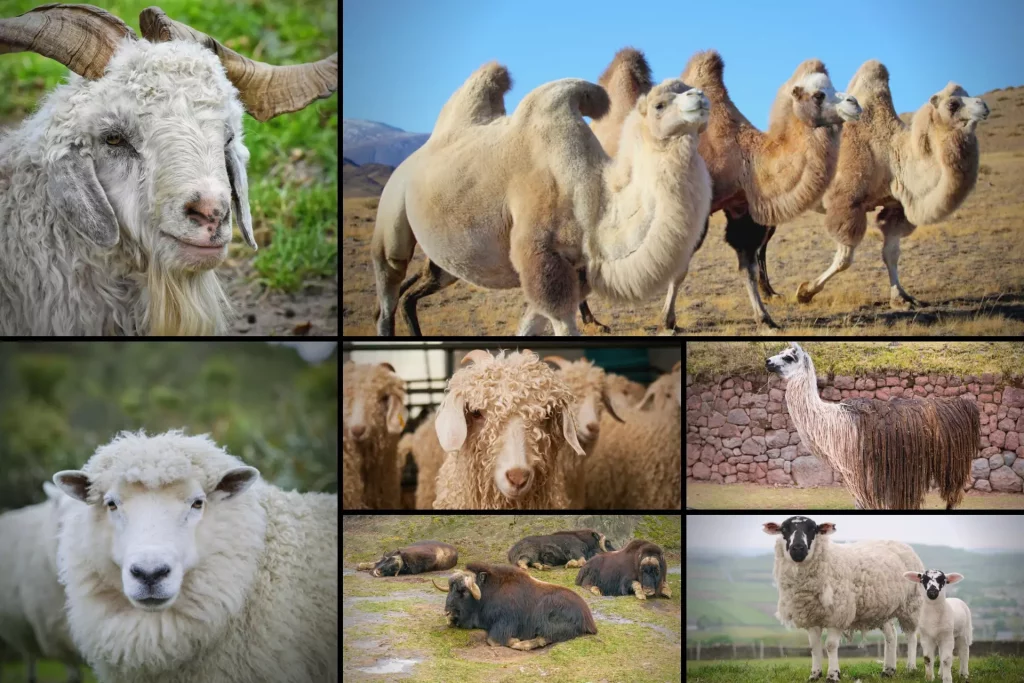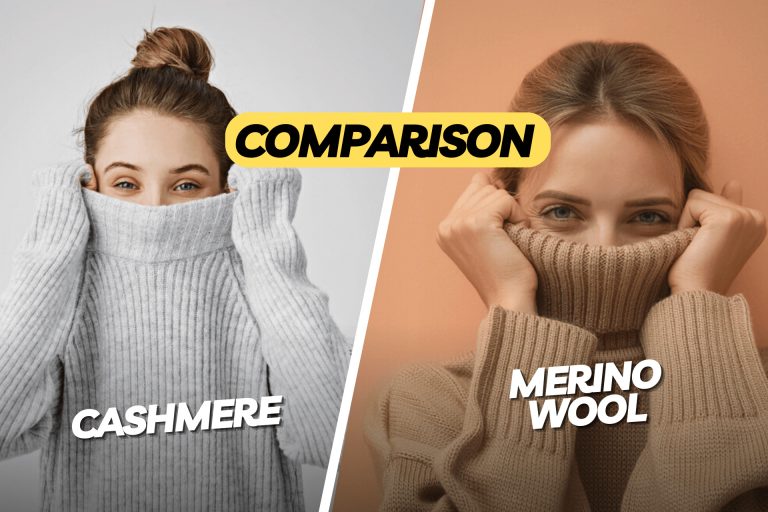The increase in various wool garments has made it difficult to find some fine-quality ones. According to the studies of Global Wool Market: East Asia by Source 2019, both merino wool and cashmere gather the most interest from customers. But, the question arises, Cashmere Vs. merino wool: which one is better?
There are many types of wool, and making wool garments in the industry differs from type to type. The internal properties of wool fabric and the manufacturing process contribute to the fineness in the quality of garments. Thus, it is important first to explore what wool material is and its different types.
Table of Contents
What is Wool?
Wool is a natural fiber that comes from the fleece of animals like goats, rabbits, camels, sheep, and many more. This material is made from keratin-based proteins that contribute to its elasticity.
Producers harvest the hairs of animals and spin them into yarn which is then transformed into garments and other textile forms. Wool and cotton have remained the only fabric forms throughout the centuries, but now each has its place in the market. However, the wool is prized higher for its unique attributes.
The quality that wool traps in the heat has made it the favorite of many. Even though the wool growing has declined over many years, its need in winters has never declined.
Types of Wool:

There are many types of wool, and not every type is derived from sheep. Each type of wool has its properties, depending upon the animal it is derived from.
Merino Wool:
The type of wool derived from merino sheep, is known as merino wool. It is one of the most common types of wool and has fascinating features.
The history of merino sheep breeding dates to Spain and now is bred in Australia in the vast majority and is used to make wool garments. This wool is one of the world’s finest wool types, with a diameter of around 20 microns.
The merino wool has a greasy existence, and before spinning it into yarn, the manufacturers ensure to remove lanolin from it. Without removing lanolin, the wool might not show useful features as it shows otherwise.
Cashmere Wool:
It is one of the most luxurious and expensive wools available in the market. The name “cashmere” originated from the Kashmir region of India, where the furry goats, from which this cashmere wool is extracted, originated.
The diameter of the sheep hair is almost 18 microns making the wool one of the finest wools in the market. Along with the quality features it offers to its wearers, the fact that this type of wool is produced only around 150 grams per year makes this wool a highly expensive and desired commodity.
Mohair Wool:
Mohair wool is a type of wool that is extracted from Angora goats. These goats are famous for their thick and wavy wool and are thus very easy to get from the goats without even hurting them.
The hair of angora goats is wavy, and thus the mohair wool extracted from it is highly crimped. This is used in high-crimp woolen textile manufacturing industries. In the early 1970s and 1980s, people loved wearing mohair sweaters and putting mohair carpeting in their homes.
Alpaca Wool:
The wool extracted from the South American camelid mammal named Alpaca is known as alpaca wool. South America has been famous for breeding alpacas for several years and has been one of the major providers of this wool type.
Various breeds of alpacas found worldwide are bred for their wool. However, Suri alpaca is one of the most prized ones among these natural textiles. Most produce uses pure alpaca wool to make their garments, while some mix some less expensive wool varieties.
There is only one disadvantage to alpaca wool: it roughens as it ages, and thus the hair fibers of older alpacas are not usable for apparel purposes.
Camel Wool:
It has remained one of the most favorites among the people of the 20th century for its insulative properties. However, this wool is less durable and is relatively rough than other types of wool; it is not used for apparel making that directly touches the skin.
Virgin Wool:
This is lamb’s wool that is made from its first shearing. This is a non-recycled version of the lamb’s wool and is softer to touch.
Angora Wool:
There is a special breed of rabbit with extremely fine and soft hair; the wool extracted from this rabbit is Angora wool. This wool is highly expensive as the rabbits which produce this wool are kept in special conditions, which is different from humane conditions.
Vicuna Wool:
This type of wool is the most expensive wool that ever existed. It is obtained from vicuna that is relative to the alpaca/llama. The overpricing of wool is mainly because the Peruvian government attempts to protect this precious animal species.
Llama Wool:
This is another type of wool used for the manufacturing of garments. The wool is too rough to be worn next to the skin, but it is best to manufacture the outer garments. However, the producer for this llama wool is rare to find.
Qiviut Wool:
The qiviut wool is extracted from qiviut-a type of musk ox generally found in Alaska. The fibers obtained from this wool are highly insulative-almost 8 times the insulation capacity of other wool fibers.
Though this wool is rough to touch, it is ideal for hats, gloves, and other types of winter gear.
All these wools have their place in the market and distinctive features, but Cashmere and Merino wool are two of the most common types.
Cashmere Vs. Merino Wool:
The cashmere and merino wools are perfect in their existence with multiple features to impress their customers. However, a difference between the two raises the debate of comparison.
Merino Wool:

As merino wool comes from one of the finest sheep breeds, it has unavoidable features and properties. It is best for manufacturing garments and is perfectly softer and smoother to touch.
Some Uses and Benefits of Merino Wool:
Like many other fibers in the market, merino wool also has multiple benefits that make it a durable, more comfortable, and fashionable choice altogether.
Here is the list of benefits that would make you fall in love with merino wool material:
- Merino Wool is All-Natural: Wool is a natural fiber and is one of the most effective materials that offer all-weather protection to man. Its natural composition is such that it makes the material perfect to be used, especially in winters.
- It is Safer to Wear: Compared to other fibers like Synthetics and cotton, wool fiber is safer. It is because wool has the natural ability for UV protection.
- It is Fire Retardant: Wool fiber is fire retardant. Any garment made entirely of wool doesn’t catch fire. Even if it catches fire, it burns slowly and self-extinguishes when the flame source is removed.
- It is Biodegradable: The decomposition time for the merino wool is only a few hours, so it gets decomposed very quickly. This wool type can also be put into the soil to grow crops.
- It is Breathable: The amazing feature of this wool type is that it absorbs moisture. The moisture vapor and sweat evaporate quickly from the body, and you always feel fresh, and skin is extremely breathable all the time.
- It is Durable: Merino wool fiber is extremely durable and can be bent as many times as possible, and it doesn’t break. It recovers and returns to its original shape within no time. This is why this wool type looks good and fresh for longer.
- It is Multi-Climate: Merino wool is multi-climate; it can be worn in winters and summers. It is temperature regulating which means it keeps you warm during winters and keeps your body active and fresh during summers.
- It is Elastic: Merino wool fibers are naturally elastic and are stretchable. It takes the shape of the wearer’s body and provides utter comfort. The best thing about this wool is that it gets back to its original shape when taken off.
Cashmere Wool:

Cashmere material is one of the expensive wool materials currently available in the market. It is used in high-end clothing and textile products. It has some unique properties and has gained a reputation that justifies its premium price.
Features and Benefits of Cashmere Wool:
- It is Soft: Cashmere has a luxurious feel, and it is known for its softness. It’s soft because it comes directly from the softer fleece underlayer. The softness of wool fibers is extremely fine- less than 19 microns that is less than the human hair that is between 60 and 120 microns. Cashmere is a high loft fiber that gives a silky feel when touched to the skin. Besides, when this wool is properly taken care of, it becomes softer with age.
- Insulation Properties: Cashmere is known to be eight times more insulating than ordinary sheep’s wool. This is because the sheep lives in extreme weather conditions, and its fur keeps it protected in those. So, this wool, when extracted from the sheep, and transformed into garments, is comfortable and provides the best insulating properties in winter.
- It is Light Weight: Cashmere is very easy to carry. When compared with the warmth it provides, it is extremely lightweight. The cashmere garments are never bulky and make you comfortable while wearing them.
- Wrinkle-Resistant: Cashmere wool is wrinkle-resistant, which means that it is perfect to have as a traveling garment. The garments made of this wool will be best to have with you anywhere in the world.
- Comfortable to Feel/ No Scratchiness: Cashmere woolen garments are supremely comfortable to feel and provide you with zero scratchy feeling against the skin. The finer wool fibers make the garment feel softer and smoother against the skin.
- Breathable: Cashmere garments are breathable, and they regulate your body temperature, which helps keep your body fresh and active.
- Fire Resistant: Like merino wool, cashmere wool is also fire resistant. It doesn’t catch fire, and when brought closer to the skin, it smolders and doesn’t melt into the skin.
- Hypoallergenic: Cashmere wool is hypoallergenic and has properties that are best to use for people with allergies and kids. You can also benefit from the cashmere woolen blankets.
Frequently Asked Questions:
How much does cashmere wool cost?
Cashmere wool is one of the finest and softest available wools in the market, making it one of the most luxurious and expensive wools around. However, the price of cashmere wool depends greatly on the seller.
How much does merino wool cost?
Merino wool yarn can cost you as much as $10 to $40 per ball. Along with the fineness of the wool fiber, the amount of labor involved in the wool making also affects its price.
When is the best time to wear cashmere?
Though the cashmere wool is warm, it is best to wear in winter. But the fact that it is lighter and is breathable also makes it the best thing to wear all around the year.
Cashmere Vs. Merino Wool; Which is Better?
Considering the properties and features of both wool types, the debate ends at the personal preference of a person for either of them.
For instance, if you need garments that are best in features and ready to spend as much money as it demands, buying garments made of cashmere wool is the best choice. And, if you need woolen garments with quality features and at a lesser price, you should probably go for merino wool clothing.
Thus, it all depends upon the person’s choice of which of the wool types suits them best. Keeping in view the properties of fire resistance, breathability, weight, breathability, and others, you can make your choice and buy any of the two.

